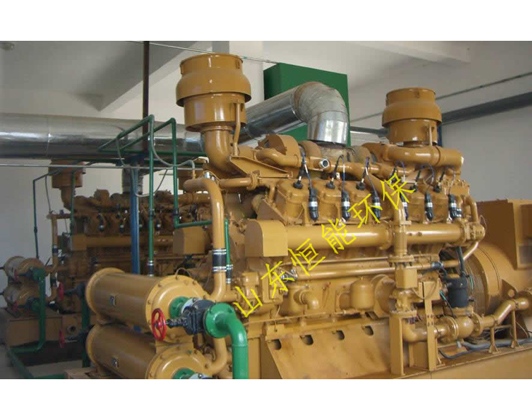沼氣脫硫原因:沼氣中含有水份,水分對沼氣的利用影響大,沼氣中的水分與硫化氫共同作用,能加速管道及閥門、流量計等的腐蝕,對家用電器也有腐蝕作用。為正常供氣,延長設備的使用壽命,在輸氣管路中須安裝沼氣脫硫器。所以在進行沼氣脫硫時,需要同時進行脫水處理。去除沼氣中的水分,增加產出沼氣的質量。
Reasons for biogas desulfurization: biogas contains water, which has a great impact on the utilization of biogas. The combined action of water in biogas and hydrogen sulfide can accelerate the corrosion of pipelines, valves and flow meters, and also have a corrosive effect on household appliances. In order to supply gas normally and prolong the service life of the equipment, a biogas desulfurizer must be installed in the gas transmission pipeline. Therefore, during biogas desulfurization, dehydration treatment needs to be carried out at the same time. Remove the moisture in biogas and increase the quality of biogas.
沼氣脫硫方法:沼氣脫硫器的脫硫方法有濕法和干法脫硫兩種,干法脫硫具有工藝簡單、成熟可靠、造價低等優點,并有較好的凈化效果。
Biogas desulfurization methods: the desulfurization methods of biogas desulfurizer include wet desulfurization and dry desulfurization. Dry desulfurization has the advantages of simple process, mature and reliable, low cost and good purification effect.

沼氣脫水器外部采用碳鋼結構,內部防腐處理,當沼氣以一定的壓力從上部的進氣口進入后,水滴在離心力作用下旋轉與脫水器壁發生碰撞,使水滴失去動能與沼氣相分離,以達到除塵和脫水的目的。而后器內的水滴沿內壁向 下 流動,而存于裝置底部;并定期排除。
The outside of the biogas dehydrator adopts carbon steel structure and internal anti-corrosion treatment. When the biogas enters from the upper air inlet under a certain pressure, the water droplets rotate and collide with the dehydrator wall under the action of centrifugal force, so that the water droplets lose kinetic energy and separate from the biogas, so as to achieve the purpose of dust removal and dehydration. The water droplets in the latter flow downward along the inner wall and are stored at the bottom of the device; And eliminate it regularly.
沼氣脫硫脫水工藝流程:
Biogas desulfurization and dehydration process flow:
從軟體沼氣池中出來的沼氣中含有大量的水氣、粉塵雜質、硫化氫等有害氣體。沼氣經過初步脫水除塵后然后進入脫硫器,利用合理的反應條件可將沼氣中的硫化氫脫至200ppm以下,脫硫后的沼氣進入沼氣增壓風機進行增壓輸送,增壓后的沼氣進入緩沖系統進行緩沖,一方面進行沼氣除雜處理,另一方面穩定送氣壓力,以保后續發電機組的穩定運行,緩沖穩壓后的沼氣進入終端用氣設備。
The biogas from the soft biogas digester contains a lot of harmful gases such as water gas, dust impurities and hydrogen sulfide. After preliminary dehydration and dust removal, the biogas enters the desulfurizer. The hydrogen sulfide in the biogas can be removed below 200ppm by using reasonable reaction conditions. The desulfurized biogas enters the biogas booster fan for pressurized transmission, and the pressurized biogas enters the buffer system for buffering. On the one hand, the biogas is subject to impurity removal and on the other hand, the gas supply pressure is stabilized, In order to ensure the stable operation of subsequent generator units, the buffered and stabilized biogas enters the terminal gas equipment.
沼氣脫硫器維護和保養:
Maintenance of biogas desulfurizer:
使用一段時間后,脫硫器內的脫硫劑會變黑,失去活性,脫硫效果降低,也可能板結,增加沼氣輸送阻力,嚴重時,沼氣會被阻塞不能通過。此時,須將脫硫劑進行再生。
After using for a period of time, the desulfurizer in the desulfurizer will turn black, lose activity, reduce the desulfurization effect, or harden and increase the resistance of biogas transmission. In serious cases, the biogas will be blocked and cannot pass through. At this time, the desulfurizer must be regenerated.
再生的方法:是將失活的脫硫劑取出,均勻疏松地堆放在平整、干凈、背陽、通風的場地上,經常翻動脫硫劑,使其與空氣充分接觸氧化再生。當脫硫劑中水分含量低時,可均勻噴撒稀堿液,以加速再生速度,縮短再生時間,一般經過1個月左右,可裝入脫硫器內繼續使用。脫硫劑可以再生1~2次。
Regeneration method: take out the deactivated desulfurizer, stack it evenly and loosely on a flat, clean, sunny and ventilated site, and often turn the desulfurizer to make it fully contact with the air for oxidation regeneration. When the moisture content in the desulfurizer is low, dilute alkali liquor can be sprayed evenly to accelerate the regeneration speed and shorten the regeneration time. Generally, it can be put into the desulfurizer for further use after about one month. Desulfurizer can be regenerated for 1 ~ 2 times.
用戶可根據實際氣體氣量和氣體中硫化氫含量,量身定做沼氣脫水器外形尺寸和內部結構。不同類型的氣體,不同氣體中硫化氫含量,不同氣體壓力設計的脫硫設備尺寸不同,內部結構也不同。
Users can customize the overall dimension and internal structure of biogas dehydrator according to the actual gas volume and hydrogen sulfide content in gas. Different types of gases, hydrogen sulfide content in different gases and different gas pressures design desulfurization equipment with different sizes and internal structures.
